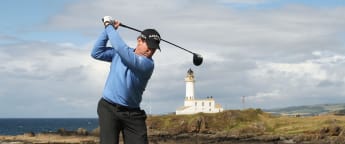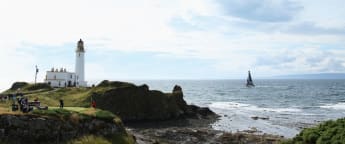Located on the rugged South Ayrshire coast in south-western Scotland, Turnberry is a golf resort with a rich and storied history over its 100 plus years in existence.

Birthplace of the great Scottish bard Robert Burns, and home to the ruins of Turnberry Castle – reputed birthplace of Robert the Bruce, King of Scots – the land has a mystique and allure befitting of its more recent sporting appeal.
Originally developed in 1902 as the first purpose built golf resort in Britain, complete with a five-star hotel that was finished in 1906, Turnberry’s land was commissioned for use by the Royal Flying Corps in World War One and then once again by the Royal Air Force during the Second World War.
The rolling fairways were flattened for use as runways and hangers not once but twice as the embryonic links were destroyed, rebuilt, destroyed once more, before Mackenzie Ross redesigned the cherished Ailsa Course between 1949 and 1951, named so after the third Marquess of Ailsa on whose land the course was built.
And the Ailsa has, over the years, hosted some of golf’s most iconic moments, from Tom Watson and Jack Nicklaus’ famed “Duel in the Sun” in 1977, when Turnberry hosted its first of four Open Championships, to four Amateur Championships, while the course will this week stage The Senior Open for a record seventh time.
Built on a bedrock of magnificent scenery, the Isle of Arran in the distance, the rolling outskirts of the outer Firth of Clyde below and the brooding Ailsa Craig rock island perched dramatically 11 miles out to sea, Turnberry is a place of tales, of theatre, and of history; a mystical aura derived as much from its diverse past as it is the golfing ancestry bred into its fabled links.
Par: 70
Length: 7,105 yards
Course Record: 63 (-7); Mark Hayes, 1977, Greg Norman, 2003, Eduardo Romero, 2006
Architects: William Fernie, 1902, re-designed by Mackenzie Ross, 1951
Insider knowledge
Ricky Hall, Head Professional at Turnberry, spoke to europeantour.com ahead of the tournament to give his assessment of the Ailsa Course and identify its unique challenges and the holes that may define where the Senior Open is won and lost.
Overview
“I think that first and foremost out of all The Open Championship courses this is in my opinion the fairest. It’s all in front of you; there are not really any blind shots so you pretty much know what you need to do.
“A lot of the greens sit in a sort of saucer shape so if you are in the middle of any of the putting surfaces then you have a good chance of holing the putts.
“There are a number of challenges out there. With the way the weather has been the rough is thick in places, it’s probably similar to last week at Royal Lytham and St Annes that it’s perhaps not quite as consistent as we would like it so there is some areas that are going to be very tough to get out of.
“If it stays benign then the course won’t show its teeth but with the prevailing wind – when it does come in – the final stretch of 15, 16, 17 become three very tough holes that they’ve got to get through and so it certainly won’t be over until the winner’s got through the last four holes on Sunday.”
Key holes
16th hole – 422-yard par four
“The 16th jumps out to me first and foremost. We changed it quite a lot for the 2009 Open Championship; we lengthened it, changed it into a slight dogleg left to right which has changed the character of the hole completely and so all of a sudden that has gone from a hole that yields a fair few chances to one that the players really are going to have to take care with.
“Into the prevailing wind, it’s a drive and then they will be leaving themselves somewhere around 180 to 200 yards in over the little burn into a green that slopes back towards the burn so there’s definitely care to be taken there and it’s a hole that will certainly cause some problems throughout the week – just as it did in 2009.
14th – 454-yard par four
“Always a tough hole, was ranked right up there as one of the toughest in 2009. Another long par four, there are two new bunkers off the tee on the right hand side and the fairway slopes in towards them. If players find either of those they won’t be able to make the green and then on the other side we have mounded a little area of rough on the left hand side so that is probably one of the tightest that they’ll face all week.
“And again from the tee shot – even if you find the fairway – you are still left with a long iron into a subtly-awkward green so 14 will definitely be another they want to get out of the way without posting a big number.
The iconic turn: 9th hole – 458-yard par four/10th holes – 457-yard par four
“The holes either side of the turn you would probably say are two of the Ailsa’s signature holes but they are again a real test that the players will be thankful to get through. Nine is a difficult fairway to hit and the new tee at ten presents a tricky carry over the coastline plus two fairway bunkers that leave you pretty much dead if you find them.
“With chances before and chances after, players will be more than happy with a four-four at nine and ten, take their pars and run.”












